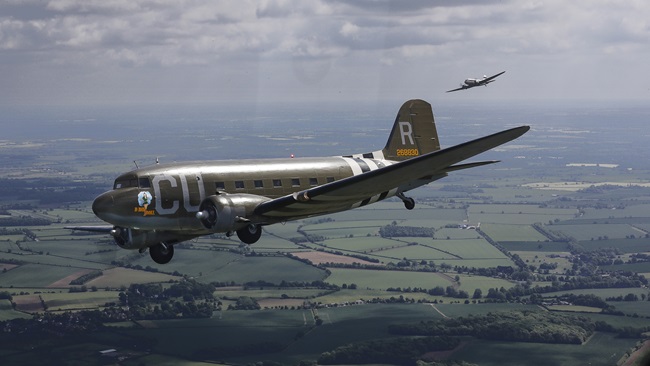Stinson Model O
Boy, ‘O,’ boy!
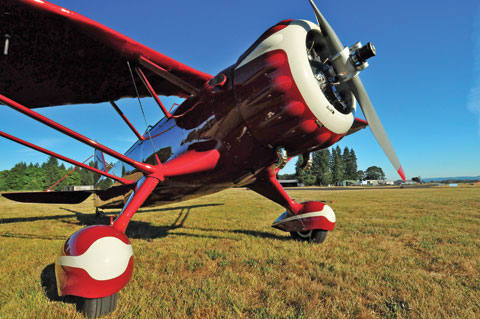
In the movie Jurassic Park scientists re-created living dinosaurs using DNA taken from long-dead mosquitoes preserved in amber. That was fiction, but now there’s a real, live aeronautical equivalent. Working from “genetic” information contained in 20 old photographs and an antique airplane, Jeff Paulson and his crew at Evergreen Aviation Services in Scappoose, Oregon, have brought back to life the Stinson Model O—an airplane that had been extinct for more than 50 years.
The genesis of the project came in the late 1990s when Brad Poling, a retired sales professional from Sacramento, California, decided to build an airplane. He was attracted to an unusual design—the Westfall W–7, a sleek cabin biplane with reverse-staggered wings. The resemblance to the Beech Staggerwing of the 1930s led him into historical research, and while poring through a dusty archive, he stumbled across a very unusual airplane. It was a Stinson, but it didn’t look like any Stinson he’d ever seen. Like other Stinsons of the 1930s, it had a radial engine and bump cowl, but there the resemblance ended. The wing was a parasol; suspended from it was a long fuselage with two open cockpits. In fact, it was the only open-cockpit airplane Stinson ever built—the Model O.
“I completed the Westfall in 2001, and was looking for another project. The Model O was still on my mind. I just liked the cut of its jib,” says Poling. “When I attempted to locate a full-size example as a restoration project, I hit a dead end, but I did learn the story behind the airplane.”
The Model O was originally designed by Robert Hall, who also designed the Gee Bee racers and the Hall “Bulldog” parasol racer. He later served as design engineer and test pilot for the famous Grumman “Cat” series of World War II navy fighters, the Avenger torpedo bomber, and other Grumman airplanes well into the jet era.
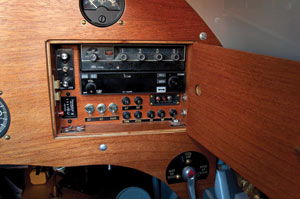 The Model O was probably Hall’s first military airplane. He joined Stinson in 1933, just in time to receive a visit from Lowell Yerex, who operated several Stinson airplanes in South America. Yerex was in the market for a military trainer/light attack/utility airplane and wondered what Stinson might have to offer. Nothing in the Stinson line would suit, so Hall proposed taking the wing and landing gear from the Stinson SR and mating them with a new fuselage.
The Model O was probably Hall’s first military airplane. He joined Stinson in 1933, just in time to receive a visit from Lowell Yerex, who operated several Stinson airplanes in South America. Yerex was in the market for a military trainer/light attack/utility airplane and wondered what Stinson might have to offer. Nothing in the Stinson line would suit, so Hall proposed taking the wing and landing gear from the Stinson SR and mating them with a new fuselage.
He chose a parasol wing configuration—possibly harkening back to his Bulldog—and put the pilot in the front cockpit. This freed up the rear pit, which had full dual controls, for a student pilot, or gunner if a machine-gun ring was mounted. There were also provisions for forward-firing guns and bomb racks. Power was supplied by a 220-horsepower Lycoming radial engine.
Just three months after Yerex’s visit, the new Model O was flying. Stinson eventually built 10 of them between 1933 and 1934. Five were sold to Honduras, three to China, and one to Brazil. One remained in the United States and was last seen in Texas about 1945.
“It became apparent that if I was ever to have an O, I would have to build it from scratch. I was able to locate a few photos and some text describing the airplane,” says Poling. “Modeler Ward Emigh sold me a set of quarter-scale plans he’d drawn. Bob Taylor, president of the Antique Airplane Association, sent me the only known in-flight photo. He’d taken it in 1941 as the prototype O landed at Grand Central Airport in Long Beach, California. No factory plans could be located and there are no records of the O in FAA or Smithsonian files. In April 2006, I re-contacted Ward Emigh. Ward was able to provide me with several more photos.”
Among these was a treasure: five factory photos showing the “bones” of the uncovered fuselage and wing center section. If Poling could find an SR restoration project, it might be possible to do the same thing that Stinson had done in 1933—modify the wing and landing gear and build the rest from data gleaned from the precious five photographs.
“I liked that idea, but I realized that a project of this scope was beyond what I could do by myself,” Poling recalls. “I needed a Stinson SR, a builder, and a partner. I found a partner in Jim Teel—homebuilder, pilot, and all-around old-airplane enthusiast—who shared my fondness for this unique aircraft. We went looking for a Stinson SR, but there were none to be had. In May of 2007, we did locate a similar but later airplane, an SR–5, in Nebraska. In September of 2007, we interviewed Jeff Paulson. We’d seen examples of his workmanship and knew he had the knowledge and skills we needed. We cast our lot with Jeff, made him a partner in our project, and officially got under way on November 23, 2007.”
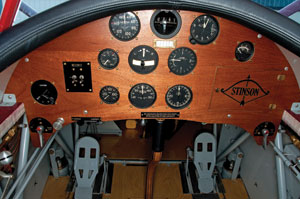 Paulson graduated Parks College with a degree in aeronautical engineering. He spent several years flying freight in Beech 18s and Piper Aztecs and as a corporate pilot flying a Baron 58. In 1997, he bought Evergreen Flying Service, an iconic institution founded and operated by Wally Olson on the Evergreen Airport in Vancouver, Washington. Evergreen was Olson’s life’s work, and he ran it as much like a 1930s aerodrome as possible. Prices were absurdly low, and old airplanes were welcome. As the new owner, Paulson felt that he’d finally come home.
Paulson graduated Parks College with a degree in aeronautical engineering. He spent several years flying freight in Beech 18s and Piper Aztecs and as a corporate pilot flying a Baron 58. In 1997, he bought Evergreen Flying Service, an iconic institution founded and operated by Wally Olson on the Evergreen Airport in Vancouver, Washington. Evergreen was Olson’s life’s work, and he ran it as much like a 1930s aerodrome as possible. Prices were absurdly low, and old airplanes were welcome. As the new owner, Paulson felt that he’d finally come home.
He restored a pair of Piper Cubs to use as trainers—on an airport like Evergreen, using Cubs was practically mandatory. The quality of that work led to a Stearman restoration. The Stearman picked up several awards at fly-ins, and soon Paulson was busy restoring a 1929 Travelair and a Fairchild 24. Those projects—and a move to Scappoose when development pressures finally overwhelmed the Evergreen airport—kept him busy, but eventually they were finished, and he was ready for something new when Poling and Teel called.
Poling and Teel purchased the SR–5 and had it hauled to Scappoose, where the old covering was removed and the structure inspected and inventoried. The wings and landing gear were good enough to modify and provide a basis for the Model O.
The wings and wing center section were tackled first. Each wing was shortened 24 inches, while the lift strut mounts were moved inboard 19 inches. The flaps were dispensed with altogether, and new ailerons were built using flap and aileron ribs from the SR.
“The center section,” Paulson recalls, “was one of the most difficult parts of the project. It has a very distinctive hourglass shape to allow access to the front cockpit. The trailing edge of the center section is actually 12 inches forward of the rear spar. Since the rear spar can’t be carried across from wing to wing, the center section has to transfer the loads, so it is essentially an all-steel truss masquerading as an airfoil. It was our great good luck that one of the two photos we had of the center section was a plan view of the uncovered structure. Using that, and dimensions taken from the wings, we built an entirely new center section from 4130 steel tube with some flat steel used for reinforcements.”
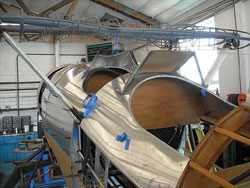 The fuselage structure was developed from several factory photos that showed parts of the uncovered Model O fuselage. Since the O and the SR–5 share a common landing gear, it was possible to digitally compare the known dimensions with other parts of the structure on a computer and accurately determine dimensions for the rest of the airframe. The resulting working drawings were lofted to a table where the tube framework was laid out and tack welded. Once the basic fuselage was welded, the center-section struts were placed, the flight and engine controls were mounted, and the seat mounts were secured. Eventually the entire airplane was re-created using the genetic material buried in the factory photographs and a growing knowledge of how Stinson did things back in the day. “We knew every pixel on those photos by the time we were done,” Paulson recalls.
The fuselage structure was developed from several factory photos that showed parts of the uncovered Model O fuselage. Since the O and the SR–5 share a common landing gear, it was possible to digitally compare the known dimensions with other parts of the structure on a computer and accurately determine dimensions for the rest of the airframe. The resulting working drawings were lofted to a table where the tube framework was laid out and tack welded. Once the basic fuselage was welded, the center-section struts were placed, the flight and engine controls were mounted, and the seat mounts were secured. Eventually the entire airplane was re-created using the genetic material buried in the factory photographs and a growing knowledge of how Stinson did things back in the day. “We knew every pixel on those photos by the time we were done,” Paulson recalls.
On March 24, 2010, under the anxious watch of Poling and Teel and the crew of craftsmen who had helped build the airplane, Paulson became the first Stinson Model O pilot of the twenty-first century (or the last half of the twentieth, for that matter). From the arrival of the SR–5 to the first flight took 28 months—or about 25 months more than it took Stinson back in 1933. Paulson laughs at the comparison. “Hey, they had an advantage—a full crew, drawings, and access to the designer,” he says.
The result is a beautiful airplane with real presence. There’s nothing delicate or light about the structure, or the flying qualities, of a Model O. It’s strong, stable, and very heavy on the controls. In the air, it takes some real muscle applied to the massive stick to change direction, but on the ground, the wide gear and lockable tailwheel make it easy to handle and taxi. The poor student in the back seat endures a beating from the air spilling off that aerodynamically awkward center section. The Lycoming supplies enough power and the big wing develops enough lift to get off easily, even though the re-creation is a couple hundred pounds heavier that the original—at least, it is if you believe Stinson’s numbers. It cruises at about 110 knots and will reach about 10,000 feet at gross weight.
After attending a couple of local events it was time to reintroduce the airplane to the aviation world at large—EAA AirVenture 2010 in Oshkosh. By now, Paulson was confident in his handiwork and comfortable in the airplane, so the partners decided to make the trip. Paulson flew solo from Scappoose to Billings, Montana, where Teel met him. Together, they rumbled across South Dakota and rural Minnesota—terrain that, even from the Stinson’s low altitude, appears to have changed little from the days when the original might have crossed it on the way to California.
Displayed prominently in the Classic area at AirVenture, the Model O continuously stopped spectators in their tracks as they tried to figure out exactly what it is. At least one spectator already knew.
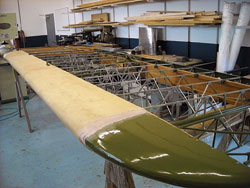 Hugh Grundy’s aviation career includes turning wrenches with Howard Hughes, piloting Claire Chennault on airborne goose hunts in China, running several airlines (including the CIA’s Air America)—and flying the original Stinson Model O. Now 95 (“I’m 96 on my Chinese pilot’s license,” he says. “The Chinese figure birth as ‘one’ and always add a year to a foreigner’s age.”), Grundy had no problem remembering the Model O.
Hugh Grundy’s aviation career includes turning wrenches with Howard Hughes, piloting Claire Chennault on airborne goose hunts in China, running several airlines (including the CIA’s Air America)—and flying the original Stinson Model O. Now 95 (“I’m 96 on my Chinese pilot’s license,” he says. “The Chinese figure birth as ‘one’ and always add a year to a foreigner’s age.”), Grundy had no problem remembering the Model O.
“In 1938, I was a student at the Curtiss-Wright Technical Institute in Glendale, California,” he says. “I had no money, so I worked weekends maintaining Joe Prosser’s school fleet. I took my pay in flight time. Prosser was learning instrument flying, so we used the Model O. He’d sit in the back under a big snap-on hood, and I’d fly up front as safety pilot. Then we’d land and switch places. I never met anybody who had heard of the airplane, so I was truly surprised to see one at Oshkosh.”
At the end of AirVenture, the Model O was named Replica Aircraft Champion. Paulson stuffed the Bronze Lindy statuette in the tiny baggage compartment and fought his way back to Oregon against stiff winds. A few weeks later, NC12817 flew to its new home near Sacramento.
“I’m in my seventies and Jim is 80,” Poling says. “We know we won’t get to fly the O for long, so we’re thinking of a good museum home for the airplane.” Meanwhile, they will fly it for their own pleasure and for the fun of introducing others to a sight nobody’s seen for more than 60 years: the long, lean shape of a Stinson Model O dragging its shadow across the California countryside.
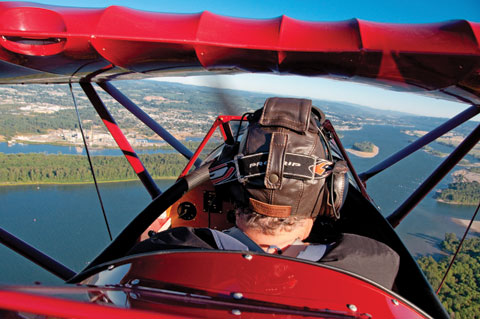
Ken Scott is a freelance writer in Oregon who works for Van’s Aircraft and owns an RV–6.

